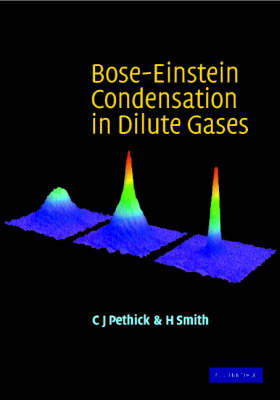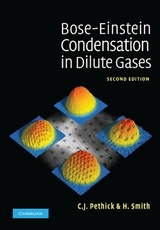
Bose–Einstein Condensation in Dilute Gases
Cambridge University Press (Verlag)
978-0-521-66194-2 (ISBN)
- Titel erscheint in neuer Auflage
- Artikel merken
In 1925 Einstein predicted that at low temperatures particles in a gas could all reside in the same quantum state. This gaseous state, a Bose–Einstein condensate, was produced in the laboratory for the first time in 1995 and investigating such condensates has become one of the most active areas in contemporary physics. The study of Bose–Einstein condensates in dilute gases encompasses a number of different subfields of physics, including atomic, condensed matter, and nuclear physics. The authors of this graduate-level textbook explain this exciting new subject in terms of basic physical principles, without assuming detailed knowledge of any of these subfields. Chapters cover the statistical physics of trapped gases, atomic properties, cooling and trapping atoms, interatomic interactions, structure of trapped condensates, collective modes, rotating condensates, superfluidity, interference phenomena, and trapped Fermi gases. Problem sets are also included in each chapter.
Christopher Pethick graduated with a D.Phil. in 1965 from the University of Oxford, and he had a research fellowship there until 1970. During the years 1966-1969 he was a postdoctoral fellow at the University of Illinois at Urbana-Champaign, where he joined the teaching faculty in 1970, becoming Professor of Physics in 1973. Following periods spent at the Landau Institute for Theoretical Physics, Moscow and at Nordita (Nordic Institute for Theoretical Physics), Copenhagen, as a visiting scientist, he accepted a permanent position at Nordita in 1975, and divided his time for many years between Nordita and the University of Illinois. Apart from the subject of the present book, Professor Pethick's main research interests are condensed matter physics (quantum liquids, especially 3He and 4He and superconductors) and astrophysics (particularly the properties of dense matter and the interiors of neutron stars). He is also the co-author of Fermi Liquid Theory: Concepts and Applications (1991). Henrik Smith obtained his mag. scient. degree in 1966 from the University of Copenhagen and spent the next few years as a postdoctoral fellow at Cornell University and as a visiting scientist at the Institute for Theoretical Physics, Helsinki. In 1972 he moved to the University of Copenhagen where he is now a professor at the Oersted Laboratory. He has also worked as a guest scientist at the Bell Laboratories, New Jersey. Professor Smith's research field is condensed matter physics and low-temperature physics including quantum liquids and the properties of superfluid 3He, transport properties of normal and superconducting metals, and two-dimensional electron systems. His other books include Transport Phenomena (1989) and Introduction to Quantum Mechanics (1991).
1. Introduction; 2. The non-interacting Bose gas; 3. Atomic properties; 4. Trapping and cooling of atoms; 5. Interactions between atoms; 6. Theory of the condensed state; 7. Dynamics of the condensate; 8. Microscopic theory of the Bose gas; 9. Rotating condensates; 10. Superfluidity; 11. Trapped clouds at non-zero temperature; 12. Mixtures and spinor condensates; 13. Interference and correlations; 14. Fermions; Appendix. Fundamental constants; Index.
| Erscheint lt. Verlag | 29.11.2001 |
|---|---|
| Zusatzinfo | 1 Halftones, unspecified; 36 Line drawings, unspecified |
| Verlagsort | Cambridge |
| Sprache | englisch |
| Maße | 179 x 255 mm |
| Gewicht | 1008 g |
| Themenwelt | Naturwissenschaften ► Physik / Astronomie ► Angewandte Physik |
| Naturwissenschaften ► Physik / Astronomie ► Atom- / Kern- / Molekularphysik | |
| Naturwissenschaften ► Physik / Astronomie ► Festkörperphysik | |
| Naturwissenschaften ► Physik / Astronomie ► Thermodynamik | |
| ISBN-10 | 0-521-66194-3 / 0521661943 |
| ISBN-13 | 978-0-521-66194-2 / 9780521661942 |
| Zustand | Neuware |
| Informationen gemäß Produktsicherheitsverordnung (GPSR) | |
| Haben Sie eine Frage zum Produkt? |
aus dem Bereich



